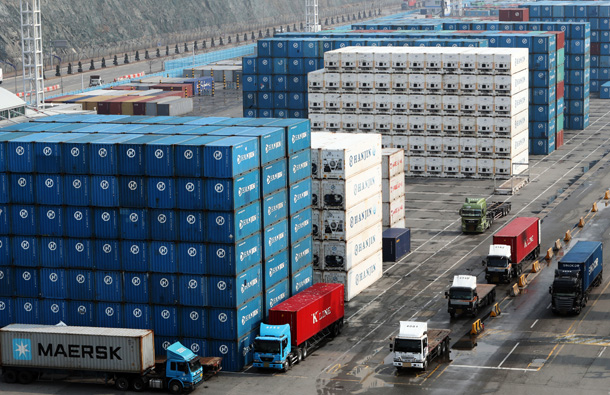Seoul court declares end of Hanjin Shipping

Tons of empty containers remain idle at Hanjin Shipping’s terminal in Busan New Port on Friday, when the company was declared bankrupt. [YONHAP]
Hanjin, once Korea’s largest and the world’s seventh biggest shipper, went into court receivership last September. On Friday the Seoul court ruled it was better for the company to be wound up rather than attempting a turnaround.
The reverberations of Hanjin’s collapse continue.
Korea’s trade balance in the shipping sector recorded a deficit of $530.6 million last year, the first deficit since 2006, when the central bank started compiling data in its current form.
Korea’s container fleet capacity fell nearly 55 percent from 1.02 million 20-foot equivalent units (TEUs) before Hanjin filed for court receivership in May to 467,290 TEU on Friday, global shipping intelligence firm Alphaliner said.
The Ministry of Strategy and Finance said Friday that it will assist with cargo that has yet to be delivered by Hanjin and help its laid off workers find jobs. The government’s assistance includes expanding financial packages offered to other shipping companies in the country, including Hyundai Merchant Marine, to prevent the whole industry from collapsing.
“The government has worked hard since Hanjin went into court receivership last year to reduce the negative impact,” said Moon Kyung-hwan, a director at the Finance Ministry. “About 98 percent of cargo carried by Hanjin has been delivered and nearly 99 percent of crewmen were returned to their home countries as of Thursday. We also have provided 480 billion won [$419 million] worth of financial support to companies affected by doing businesses with Hanjin.”
The Finance Ministry said it will spend a total of 6.5 trillion won to help the shipping industry.
“The global shipping industry will continue to be sluggish for a period of time and large shippers are likely to compete fiercely in the market,” said Moon. “We need to improve the competitiveness of the local shipping industry by helping saving on operational costs while maintaining their credibility abroad.”
The government’s plans include establishing a 1 trillion won fund with state-run banks to proceed with sale and leaseback transactions with local shippers. Through the transactions, the government will acquire ships but allow sellers to use them as they used to.
“We will first make leaseback transactions with Hyundai Merchant Marine to buy 10 of their ships and this will help the shipper’s profit go up by more than 200 billion won in five years,” an official at the Finance Ministry said. “Hyundai will be able to secure more than 500 billion won liquidity from the deal.”
The government also plans to create a fund worth 1 trillion won by 2020 to help domestic shippers acquire or invest in assets together such as terminals.
Meanwhile, due to the collapse of Hanjin last year, shipments from the country dropped but are recovering thanks to the both local and international shippers.
Transshipment volumes at Busan Port, the biggest in the nation, dropped 2.8 percent in 2016 when compared to the previous year. But that figure has been going up as orders were picked up by Hyundai and other international shippers.
BY KIM YOUNG-NAM [kim.youngnam@joongang.co.kr]










with the Korea JoongAng Daily
To write comments, please log in to one of the accounts.
Standards Board Policy (0/250자)